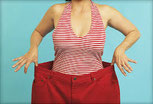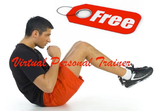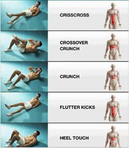
So... you are ready to lose weight, tune your abs, etc but do not have time to go to the gym or want to spend money on those expensive machines AND also .. you want it from home! If so, this is the right article for you. But how can you achieve this? Of course, we all have busy lives and cannot dedicate many hours a day to reach these goals. But the good news is that it is possible to reach these goals with appropriate advice about the right exercise techniques. However, it is not gonna be an easy path because the most important is that you must be very motivated and constant. In addition, a healthy life style including a logical diet is also important but this is the focus of other or our articles.
This article is all about the right exercises, the five most effective ones to reach your goals. People can do all of these at home, at work, on vacation, or almost anywhere without any elaborate equipment and a constancy to reach your goals!. This is the philosophy of Virtual Personal Trainer.
No need to mention that any exercise program depends on your current health status. Please make sure that your health is appropriate for exercise prior to attempting a new work out program.
Interval training
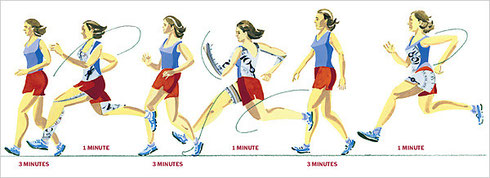
Before starting, we will make a brief introduction to Interval Training. This refers to doing almost any type of exercise at a variable pace. For example, if you are walking or doing push-ups, vary the pace of the exercise. You can walk normally for a minute or so, and then speed up a bit, and then return to normal speed several times. For exercises like push-ups, do a few slowly and do others more quickly and, like walking, repeat these faster and slower intervals several times. Interval training helps the body to adjust its aerobic system (heart rate, breathing, and metabolism) to burn more calories to lose weight and strengthen and tune muscles. Allow Interval Training to arrange your exercise routine for better and faster results.
1. Walking
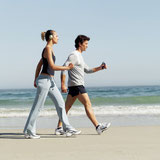
A walk is probably the best exercise to complement and begin with any exercise program. It is an excellent calorie-burning cardiovascular exercise. One hour of interval walking can burn about 500 or more calories. It takes about 3500 calories to lose a pound so you could lose a pound for every week you walk for an hour. Caution! Beginners should start walking about 5 to 10 minutes at a time and slowly increase their times by about 5 minute intervals to allow the cardiovascular system and muscles time to adapt to the new demands.
2. Push-ups
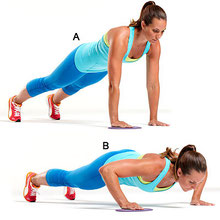
The second best in our opinion is probably the classic push-up exercise in order to strengthen the upper body (chest, shoulders, and triceps) and core (abdominal muscles). Beginners can first do push-ups by spreading their fully extended arms slightly more than shoulder width apart with their hands against an unmovable object like the edge of a kitchen countertop. Then bend your elbows until your chest almost touches the edge of the counter op, allowing only your toes to bend and keeping your back and legs in a straight line. Then push your body away from the countertop until your arms are again fully extended. As you progress, you should use lower stationary objects (for example, a stationary bench) and eventually do the push-up with your hands on the floor.
3. Abdominal crunches
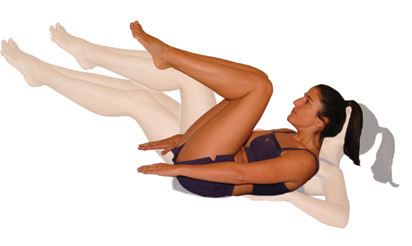
Our third pick is the standard abdominal crunch, as an excellent way to strengthen and define those abdominal muscles (commonly termed a “six pack”). There are two ways to start: either with you lying on the floor or on a non-slip rug with your hands placed lightly behind your head (never pull your head up with your hands or arms) and with your knees bent so your feet are flat on the floor. Some experts suggest doing the same with your knees bent and your feet not touching the floor. When you keep your feet off of the floor, it helps you avoid arching your back, a problem that can actually weaken the abdominal muscles. The “crunch” is done by not arching the back. The lower back is pushed downward and then contracting the abdominal muscles and tucking in your chin slightly, lift your neck, shoulders, and back off of the floor. Experts suggest you hold the raised position for a second or so before returning slowly to the starting position. A variation to strengthen and define the oblique abdominal muscles uses the same technique except you must twist your abdomen to the right or left before lifting the head, shoulders, and back. Although many people think the way to lose belly fat is to do crunches, it is not. Belly fat that covers up those “six packs” is reduced by burning more calories than you take in, so, paradoxically, if you want that “six pack” to show, most of your effort should go into not eating many caloric foods.
4. Squats

For # 4.... this exercise is an excellent calorie burner because squats use the largest muscle groups in the body (quadriceps and hamstrings or the thigh muscles and the gluteals or buttocks). Squats are exercises that consist of an up and down motion of the body that resembles the motion of getting out of a chair. In fact, some trainers suggest that a person new to trying to do squats can practice by getting up and down from a chair. The proper way to begin is to keep your back straight, feet spread apart about shoulder length with both arms extended, knees over the ankles and then go downward with your butt just touching the chair, then return to your original standing position. Eventually, stop using the chair and you will be doing effective squats. Some people with knee discomfort may be concerned about doing squats. They should check with their doctor or orthopedist but some knee problems result from quadriceps problems and squats may help resolve them. Also, avoid bending your knees to 90 degrees or less.
5. Lunges

And finally our #5 pick .... Lunges work the same large muscle groups as the squats, but can work additional leg muscles and improve balance. Lunges are done by taking a big enough step forward that the knee forms about a 90-degree angle. However, you must to keep your spine in a neutral position (upright position, no bending forward). Your trailing leg, at the same time, should have its knee come close to the floor and have the toes accept significant body weight. Then, return to a standing position and repeat with the other leg. After you master the lunge, you can vary the exercise by placing the advanced leg to the right or left to mimic more variable movement, such as the angles you might encounter during a nature hike.
Do you want to be part of an experimental health program?
We encourage you to test what has been discussed on this blog by yourself and let us know about your experience, your progress and achievements in the comments section below. The results of these experimental program will be presented at international conferences and hopefully published in high impact medical and scientist journals. Your involvement and interaction as well as your contribution is important for us since the information and voluntary donations you provide will be further used for adapting, modifying and improving our programs.
Important notice
This Online Personal Trainer's approach is recommended for healthy adults only. This site is not intended for use by minors or individuals with any type of health condition. Such individuals are specifically advised to seek professional medical advice prior to initiating any fitness or nutrition effort or program.



